Solar panels (batteries) for home
With constantly rising electricity prices, you will inevitably begin to think about using natural sources for electricity supply. One of these possibilities is solar panels for a home or summer cottage. If desired, they can fully meet all the needs of even a large house.
The content of the article
Solar Power System Design
Converting the energy of the sun into electricity - this idea did not let scientists sleep for a long time. With the discovery of the properties of semiconductors, this became possible. Solar cells use silicon crystals. When sunlight hits them, a directed movement of electrons is formed in them, which is called an electric current. When a sufficient number of such crystals are connected, we get quite decent currents in magnitude: one panel with an area of slightly more than a meter (1.3-1.4 m2 with a sufficient level of illumination can produce up to 270 W (voltage 24 V).
Since the illumination changes depending on the weather, time of day, it is impossible to directly connect the devices to solar panels. You need a whole system. In addition to solar panels, you need:
- Battery. During the daylight hours, under the influence of sunlight, solar panels generate electric current for the house, summer cottage. It is not always used in full; its surplus accumulates in the battery. The stored energy is wasted in inclement weather.
- Controller. Not an obligatory part, but a desirable one (with sufficient funds). Monitors the battery charge level to prevent over-discharge or over-charge. Both of these conditions are detrimental to the battery, so having a controller extends the battery life. Also, the controller ensures optimal operation of solar panels.
- DC-to-AC converter (inverter). Not all devices are rated for direct current. Many operate on 220 volts AC. The converter makes it possible to obtain a voltage of 220-230 V.
By installing solar panels for your home or summer cottage, you can become completely independent from the official supplier. But for this you need to have a large number of batteries, a certain number of accumulators. A set that generates 1.5 kW per day costs about $ 1000. This is enough to meet the needs of the summer cottage or part of the electrical equipment in the house. A set of solar panels for the production of 4 kW per day costs about $ 2200, for 9 kW per day - $ 6200. Since solar panels for a home are a modular system, you can buy an installation that will provide part of the needs, gradually increasing its performance.
Types of solar panels
With the rise in energy prices, the idea of using solar energy to generate electricity is becoming more popular. Moreover, with the development of technology, solar converters become more efficient and, at the same time, cheaper. So, if you wish, you can provide your needs by installing solar panels. But they are of different types. Let's figure it out.
The solar battery itself is a number of photocells, which are located in a common housing, protected by a transparent front panel. For household use, solar cells are produced on the basis of silicon, since it is relatively inexpensive, and cells based on it have a good efficiency (about 20-24%). Monocrystalline, polycrystalline and thin-film (flexible) solar cells are made on the basis of silicon crystals. A number of these photocells are electrically connected to each other (in series and / or in parallel) and output to the terminals located on the body.
Photocells are installed in a closed housing. The solar cell body is made of anodized aluminum. It is lightweight and does not corrode. The front panel is made of durable glass, which must withstand snow and wind loads. In addition, it must have certain optical properties - have maximum transparency in order to transmit as many rays as possible. In general, a significant amount of energy is lost due to reflection, so the requirements for the quality of the glass are high and it is also coated with an anti-reflective compound.
Types of photovoltaic cells for solar panels
Solar panels for the home are made on the basis of three types of silicon cells;
- Monocrystalline. Each photocell is one silicon crystal. Monocrystalline solar cells have good efficiency (about 24.7%), but their cost is somewhat higher. It can be distinguished, firstly, by the uniform saturated blue color, and secondly, by the rounded edges of the photocell.
- Polycrystalline. Several small silicon crystals are combined into one photocell. They have an inhomogeneous structure, which makes them worse at absorbing sunlight. This is reflected in the efficiency (20.3%). In fact, this means that a solar panel of the same power will occupy about 20% more area.
- Thin film. They are a semiconductor layer deposited on a flexible substrate. Due to their flexibility, they can be mounted on curved surfaces. But they have low productivity (about 10.4%), so they occupy large areas (at least 2 times more than polycrystalline ones).
If you have a pitched roof and the facade is turned to the south or east, it does not make sense to think too much about the occupied area. Polycrystalline modules can quite suit. With the same amount of energy produced, they are slightly cheaper.
How to choose the right solar panel system for your home
There are common misconceptions that lead you to spend extra money on overly expensive equipment. Below are recommendations on how to properly build a solar power system and not spend extra money.
What to buy
Not all components of a solar power plant are vital for operation. Some parts are quite possible to do without. They serve to improve reliability, but without them the system is functional. The first thing to remember is to get solar panels in late winter, early spring. Firstly, the weather at this time is excellent, there are many sunny days, the snow reflects the sun, increasing the overall illumination. Secondly, discounts are traditionally announced at this time. Further tips are as follows:
- Buy solar panels for your home with an output voltage of 12 V. It is from this voltage that most household and construction equipment, LED lamps, etc. work. Appliances operating from 24 or 48 volts are much less. You can look at the passports or use the search.
- Do not use incandescent lamps for lighting. They consume too much electricity, and they work from 220 V. Replace them with LED... For them, a constant current of 12 V is what they need.
- Do not try to buy a high power system right away to cover all possible needs. To get started, buy a couple of modules without a converter / inverter, connect to them the equipment that operates on constant voltage. If you are satisfied with the system, later you can increase the power, buy an inverter and connect equipment that operates from 220-230 V. And note that the inverter, even with the load off, consumes electricity (conversion losses are about 30%). That is, at night, when everything is turned off, it simply consumes the battery charge. Moreover, it gives out a far from ideal sinusoid. In general, everything that can operate from a constant voltage is powered directly from the batteries.
If you use only these tips, and connect only appliances that operate on constant voltage, a solar panel system for your home will cost a much more modest amount than the cheapest kit. But that's not all. You can also leave some of the equipment "for later" or do without it altogether.
What you can do without
The cost of a set of solar panels for 1 kW per day is more than a thousand dollars. Considerable investment. Inevitably, you will wonder whether it is worth it and what the payback period will be. With current tariffs, it will take more than one year to wait until your money is repaid. But costs can be reduced. Not at the expense of quality, but at the expense of a slight decrease in the comfort of using the system and due to a reasonable approach to the selection of its components.
- Do not buy helium or deep discharge batteries. They are not worth their money. Even used car batteries work well with solar panels for the home. They work normally for at least another 5 years.
- In principle, you can get by with even less money. You don't have to install the controller. It costs at least $ 150 (and at high power $ 500), and its whole task is to monitor the state of charge of the batteries. If your budget is tight, buy a 12V car clock that also measures voltage, temperature. They cost $ 2-5 and practically serve the same function. And to avoid overcharging, buy an extra battery. Or two. The total capacity of the "extra" capacity must be at least 20%. This will both avoid overcharging and increase the capacity of the system.
So, if the budget is limited, you can get by with a few solar panels and batteries, the capacity of which is 20-25% higher than the maximum charge of solar panels. For health monitoring, buy a car clock that still measures voltage. This saves you the need to measure the battery charge several times a day. Instead, you will need to look at the clock from time to time. That's all for the start. In the future, you can buy solar panels for your home, increase the number of batteries. If desired, you can buy an inverter.
Determine the size and number of photocells
A good 12 volt solar cell should have 36 cells, and a 24 volt solar cell should have 72 photocells. This amount is optimal. With fewer photocells, you will never get the stated current. And this is the best option.
Don't buy dual solar panels - 72 and 144 cells, respectively. Firstly, they are very large, which is inconvenient during transportation. Secondly, at abnormally low temperatures, which we have periodically, they are the first to fail. The fact is that the laminating film greatly decreases in size during frost. On large panels, due to the high tension, it flakes or even breaks. Transparency is lost, performance drops dramatically. The panel is being repaired.
Second factor. Larger panels should have more thickness of the case and glass. After all, windage and snow loads increase. But this is not always done, since the price increases significantly.If you see a double panel, and the price for it is lower than the two "regular" ones, you better look for something else.
Once again: the best choice is a 12 volt solar panel for your home, consisting of 36 solar cells. This is the best option, proven by practice.
Specifications: what to look for
Certified solar panels always indicate the operating current and voltage, as well as the open circuit voltage and short circuit current. It should be borne in mind that all parameters are usually indicated for a temperature of + 25 ° C. On a sunny day on the roof, the battery heats up to temperatures well above this figure. This explains the higher operating voltage.
Also pay attention to the open circuit voltage. In normal batteries, it is about 22 V. And all would be fine, but if you carry out work on the equipment without disconnecting the solar panels, the open circuit voltage will damage the inverter or other connected equipment that is not designed for such a voltage. Therefore, for any work - switching wires, connecting / disconnecting batteries, etc. and so on - the first thing you should do is turn off the solar panels (remove the terminals). After going through the circuit, connect them last. This procedure will save you a lot of nerves (and money).
Body and glass
Solar panels for home have an aluminum casing. This metal does not corrode, with sufficient strength it has a small mass. A normal body must be assembled from a profile in which at least two stiffeners are present. In addition, the glass must be inserted into a special groove, and not fixed from above. These are all signs of normal quality.
Even when choosing a solar panel, pay attention to glass. In normal batteries, it is textured rather than smooth. To the touch - rough, if you hold your nails, you can hear a rustle. In addition, it must have a high-quality coating that minimizes glare. This means that nothing should be reflected in it. If the reflections of the surrounding objects are visible at least from any angle, it is better to find another panel.
Selection of cable cross-section and subtleties of electrical connection
It is necessary to connect solar panels for the home with a single-core copper cable. The cross-section of the cable core depends on the distance between the module and the battery:
- distance less than 10 meters:
- 1.5 mm2 per 100 W solar panel;
- for two batteries - 2.5 mm2;
- three batteries - 4.0 mm2;
- distance more than 10 meters:
- to connect one panel, we take 2.5 mm2;
- two - 4.0 mm2;
- three - 6.0 mm2.
You can take a larger section, but not less (there will be big losses, but we don't need it). When buying wires, pay attention to the actual cross-section, since today the declared dimensions very often do not correspond to the actual ones. To check, you will have to measure the diameter and read the section (how to do this, you can read here).
When assembling the system, you can carry out the advantages of solar panels using a multicore cable of a suitable cross-section, and for a minus use one thick one. Before connecting to the batteries, we pass all the "pluses" through diodes or diode assemblies with a common cathode. This prevents the battery from shorting out (could cause a fire) if the wires between the batteries and the battery are shorted or broken.
Diodes use SBL2040CT, PBYR040CT types. If they are not found, they can be removed from old power supplies for personal computers. There are usually SBL3040 or similar. It is desirable to pass through diodes. Do not forget that they get very hot, so you need to mount them on a radiator (you can use a single one).
The system also requires a fuse box. One for each consumer. We connect the entire load through this block. First, the system is safer this way. Secondly, if problems arise, it is easier to determine its source (by a blown fuse).

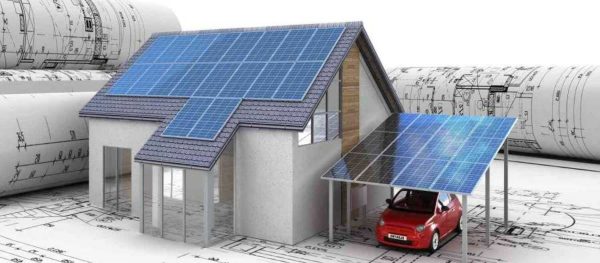
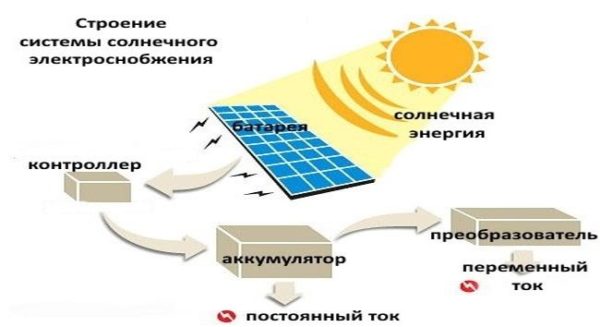
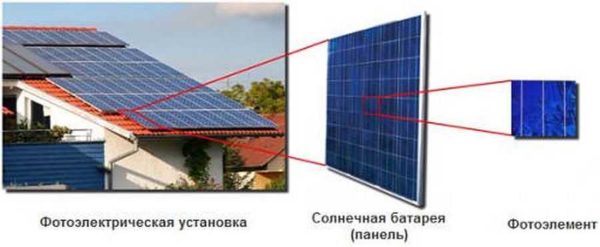
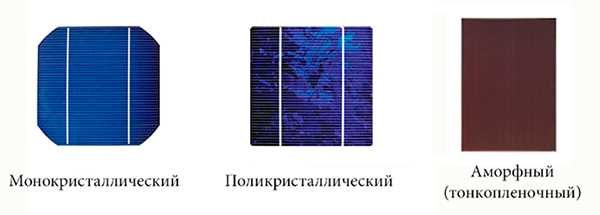
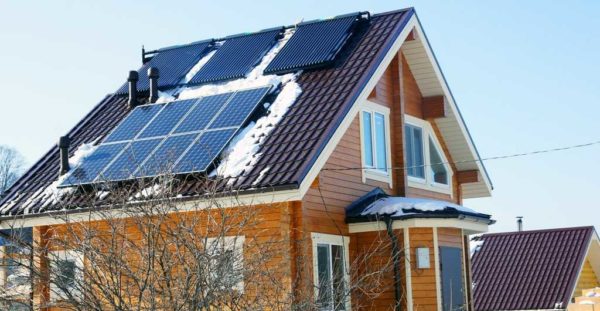
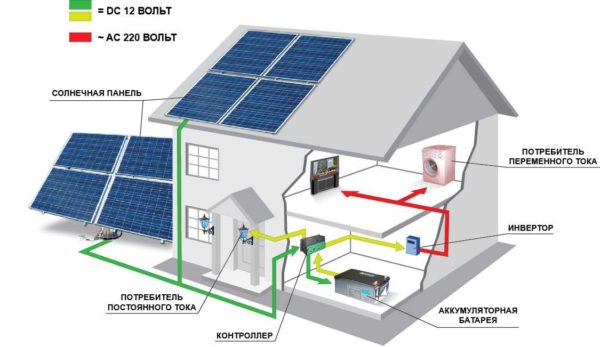
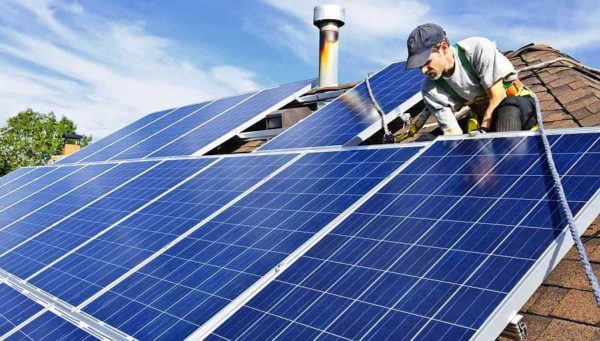
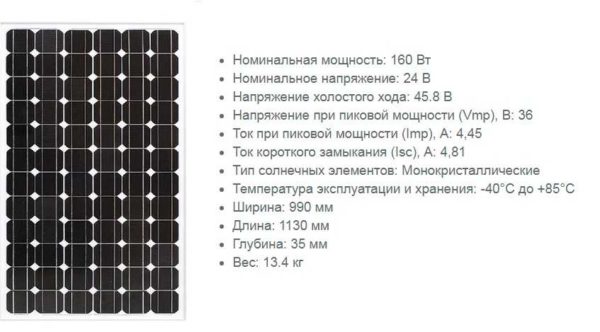

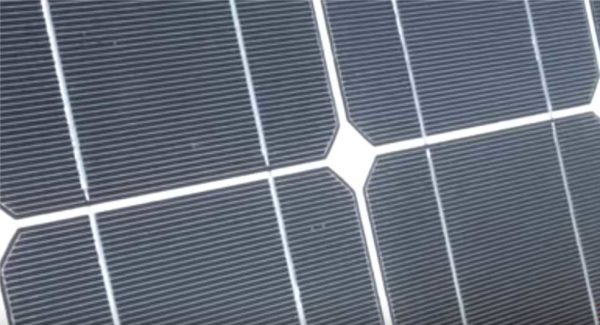
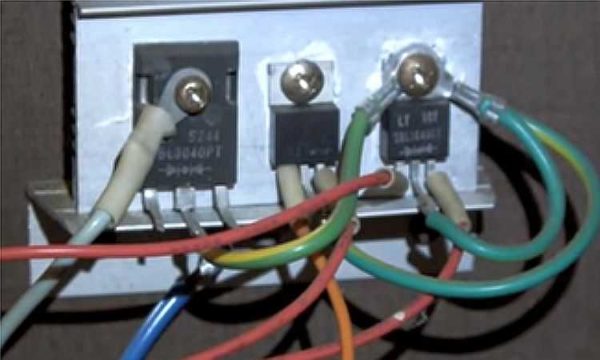










Thanks for the great article.
Thank you for your feedback. We try to collect as much information as possible and submit it as systematically as possible and we are very happy with successful articles.
Nice article. Thanks.
You have not written anything about the currents given to the load when it is cloudy. Does it make sense to buy if the sky is constantly overcast? And the article is generally wonderful.
The article is very interesting. I'm interested in how it is possible to determine how many panels I need at home and how many amperes from which parameters should I take. From the readings of the electric meter for a day or a month, or walk around the house and count? Spasbo.